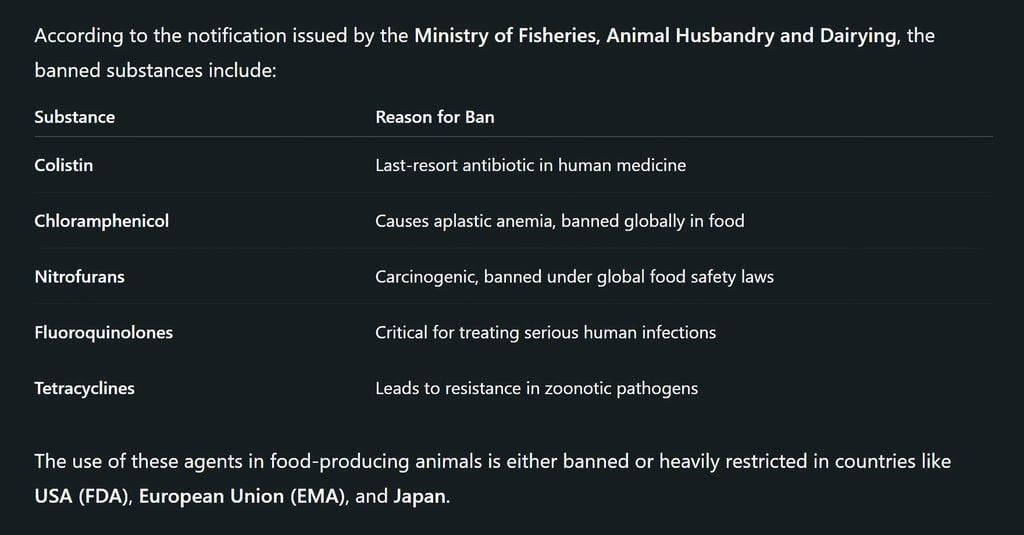
Government Prohibits Use of Certain Antimicrobial Substances in Aquaculture Industry: A Bold Move for Sustainable Seafood and Public Health
India has banned the use of high-risk antimicrobial substances in aquaculture to combat antimicrobial resistance (AMR), protect marine life, and boost export standards. Discover what’s banned, why it matters, and how this move shapes the future of sustainable fish farming.
NEWS/CURRENT AFFAIRSAWARE/VIGILANTGLOBAL ISSUES
Keshav Jha
5/11/20253 min read


As global seafood consumption surges, aquaculture has become a vital solution to bridge the supply-demand gap. However, this booming industry has also contributed to an alarming rise in the use—and misuse—of antimicrobial substances. In a landmark policy shift, the Indian government has officially banned several critically important antimicrobial agents in aquaculture, aligning with global efforts to combat antimicrobial resistance (AMR) and ensure food safety.
This development not only impacts farmers and exporters but also carries long-term implications for ecosystem health, trade compliance, and human medicine.
What Are Antimicrobials, and Why Were They Used in Fish Farming?
Antimicrobials are substances used to kill or inhibit the growth of microorganisms like bacteria, fungi, and parasites. In aquaculture, they’ve been widely used to:
Treat infectious diseases like bacterial gill disease, fin rot, and columnaris.
Prevent disease outbreaks in overcrowded or polluted fish farms.
Boost survival rates in hatcheries and nurseries.
However, their non-therapeutic or prophylactic use, often without veterinary supervision, has led to residues in aquatic environments and contributed to the global AMR crisis.
Which Antimicrobial Substances Are Now Banned?


Rising Concerns That Prompted the Ban
Alarming AMR Statistics:
India is among the highest consumers of antibiotics in food animals, including aquaculture. A study published in Nature Communications (2022) revealed that over 200,000 tonnes of antibiotics are used globally in livestock annually, and fish farms are increasingly contributing to that figure.Trade and Export Challenges:
Major seafood-importing countries like the EU, US, and Japan enforce zero-tolerance policies for antibiotic residues in imports. Indian exporters faced several rejections due to contamination, affecting both reputation and revenue.Environmental Pollution:
Antimicrobial residues leach into rivers, ponds, and coastal areas, affecting microbial diversity, harming plankton populations, and promoting resistant gene transfer in aquatic bacteria.Human Health Risks:
Consumers eating fish containing trace levels of banned antibiotics may develop resistance to treatment for diseases like tuberculosis, typhoid, and pneumonia.
Global Benchmarks and India's Alignment
India’s policy reflects global strategies like
WHO's Global Action Plan on AMR (2015): Urges reduction in antimicrobial use in animals and aquaculture.
FAO's Progressive Management Pathway for AMR (PMP-AMR): A roadmap for countries to improve antimicrobial governance in agriculture.
EU Regulation (Reg. EU 2019/6): Prohibits routine use of antibiotics in animal farming, including aquaculture.
With this move, India joins responsible aquaculture nations like Norway, Vietnam, and Chile, where stricter antibiotic protocols and alternative practices have improved export credibility and aquatic health.
Impact on Farmers and Aquaculture Businesses
Challenges
Short-term production losses due to reduced disease control.
Increased reliance on non-chemical methods requiring training.
Financial strain for small and marginal fish farmers.
Opportunities
Access to premium global markets.
Reduced long-term costs through sustainable methods.
Healthier aquatic systems and better fish survival rates.
To support farmers, the government is offering technical training, veterinary consultation access, and promoting low-cost alternatives, including
Probiotics and prebiotics
Vaccination against bacterial pathogens
Herbal immunostimulants
Improved water filtration and recirculation systems
The “One Health” Connection
This policy shift is a clear example of the "One Health" approach, which integrates human, animal, and environmental health. By limiting antimicrobial use in aquaculture:
Human antibiotic resistance risks are minimized.
Aquatic biodiversity is preserved.
Food chains become safer for consumers.
What Happens Next?
Implementation Measures
Regular monitoring of aquaculture farms and hatcheries.
Mandatory testing of fish and shrimp for banned substances before export.
Online tracking systems for antibiotic purchase and use in fisheries.
Strengthening labs like the National Residue Control Program (NRCP) for compliance testing.
Stakeholder Collaboration
Partnerships with private feed manufacturers to offer antibiotic-free feeds.
NGO involvement in educating rural aquaculture communities.
Academic research on sustainable alternatives and early disease detection.
Future Outlook: Toward Antibiotic-Free Aquaculture
This bold decision marks a turning point for India’s aquaculture industry. While the road to antibiotic-free fish farming won’t be easy, it offers long-term rewards—healthier fish, eco-friendly operations, and safer seafood for everyone.
As consumer awareness grows and global trade rules become stricter, sustainable and responsible aquaculture isn’t just an ethical choice—it’s an economic necessity.
Subscribe to our newsletter
All © Copyright reserved by Accessible-Learning
| Terms & Conditions
Knowledge is power. Learn with Us. 📚


